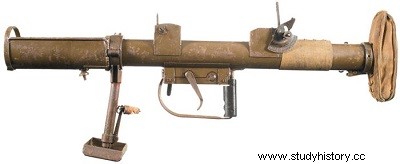
Features
Length:total , 0.99 m.
Weight:launcher , 14.510 kg;
grenade , 1.360 kg.
Range:practical , 101 m;
maximum , 338 m.
Initial speed :76 to 137 m/s.
The PIAT, acronym meaning Projector Infantry Anti-Tank Mk 1 (infantry anti-tank launcher Mk 1), had the character of a British weapon that did not conform to the selection standards imposed by the War Office. It came from a service commonly known as "Winston Churchill's Toy Shop".
It was designed to exploit the shaped charge effect and launch a grenade that was to pierce all tank armor at the time. It therefore fell into the same category as the American bazooka or the German Panzerfaust.
However, the PIAT did not use chemical energy to launch its projectile but that of a coil spring, because it operated on the principle of the pin mortar. The grenade was thrown from the housing of a tube and, at the start of its movement, a central pin kept it in its trajectory.
Pressing the trigger released a powerful spring which brought the grenade pin to hit the propellant charge of the grenade. This charge simultaneously rearmed the spring, which was ready for the next projectile to be fired.
The PIAT was primarily an anti-tank weapon, but it could also launch explosive and smoke grenades, which made it a versatile machine superior in this respect to its competitors of the time. It did great service in street fighting, and its front-mounted kickstand extended and allowed it to fire with a high site in cramped positions.
The PIAT replaced the Boys anti-tank rifle in the British and some Commonwealth armies. It was not highly regarded, however, as due to its bulk and weight, it required a two-man crew to serve it. "But its unpopularity came above all from its excessively powerful spring, which required the combined efforts of two individuals to arm it. If the grenade did not go off the first time, the PIAT became useless because it was rather risky to repeat the operation at the approach of the enemy.
On the other hand, if the grenade hit a tank, it practically put it out of action. The PIAT was not only reserved for the infantry. It constituted often the main armament of light armored vehicles such as the Universal Carriers series or certain armored cars.It sometimes equipped various means of transport which received up to fourteen examples mounted on a special support to be used as a mobile mortar battery.
The British kept it in service after World War II for a few years and replaced it as soon as they could. It was an effective anti-tank weapon.
